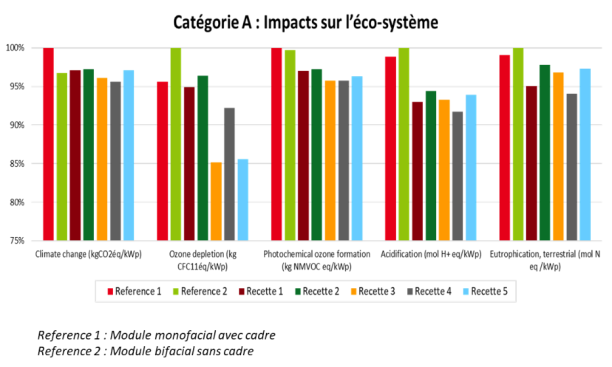Moving towards new recyclable and/or eco-composite materials, such as natural fibres and recyclable polymer resins, to manufacture photovoltaic panels and further reduce their environmental footprint. The next step in photovoltaics?

Towards eco-design of photovoltaic panels
Many developments for innovative lightweight panels are underway in our laboratories, replacing the glass used on the front side, and the glass or fluorinated polymer sheet on the back side with composite materials. Several combinations of eco-composite materials could reduce the environmental footprint.
However, the high variability of data and the low maturity of state-of-the-art results, combined with the still emerging expertise of the community on environmental aspects, are not compatible with the requirements of life cycle assessment (LCA), which requires low uncertainty and high quality data.
For bio-sourced composites with thermoset and/or thermoplastic resins, the lack of a reference framework makes the environmental analysis particularly complex. This is due to the difficulty in modelling a composite material, which is a multi-factor product by nature, as it has multiple sub-components, combinations, and possible variants depending on the proportions of fiber and resin in the same combination.
Within the framework of the ITE INES.2S, the CEA has developed a generic tool for environmental analysis of the value chain of a photovoltaic panel. The introduction of composite materials in our research and development work required the creation of a specific reference database and the addition of a function to our analysis software to configure this new family of components.

The best candidate materials (fiber and resin), the combinations and proportions of each and the processing methods were selected beforehand by our experts. This initial work allowed us to create five promising alternative recipes for further study, including a comparison of their impact with that of conventional panels on the market. The materials targeted include candidates not yet known in the photovoltaic field, such as glass, flax or basalt fibers, and bio-sourced thermoset epoxy or polypropylene thermoplastic resins. The analyses carried out show that, for all the criteria :
- The use of composites for the manufacture of panels does not increase the environmental impact compared to conventional technologies (glass/fluorinated polymer or glass/glass), but the efficiency of the cells remains an important criterion for maintaining this gain.
- The environmental gain varies from 5% to 15% according to the recipes studied on all environmental criteria.
- The environmental impact of composite materials depends mainly on the choice of resin, the choice of fiber and the quantity of these materials consumed per panel.
- Replacing or removing the aluminum frame seems to be essential to reduce the environmental footprint of the panel.
The most promising recipe for reducing the environmental footprint and ensuring the recyclability of a photovoltaic panel will be subject to a full Life Cycle Assessment to confirm its environmental benefit.
Launched in 2019, INES.2S is an Institute for Energy Transition (ITE). Led by the CEA at INES, its mission is to develop an industrial sector for the integration of photovoltaic solar energy in France, in support of the French Multiannual Energy Programming Act. The ITE INES.2S is co-financed by the French government under the Programme d'Investissements d'Avenir (ANR-10-IEED-0014-01).